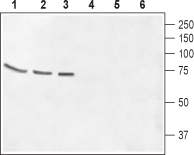Overview
- Peptide DYRMHEKLWVPDC, corresponding to amino acid residues 131-143 of mouse GABRQ (Accession Q9JLF1). Extracellular, N-terminus.
- Rat and mouse brain lysate. Human brain astrocytoma (CCF-STGI) cell lysate (1:500-1:2000).
 Western blot analysis of rat brain membrane (lanes 1 and 4), mouse brain membrane (lanes 2 and 5) and Human CCF-STGI brain astrocytoma cell lysate (lanes 3 and 6):1-3. Anti-GABA(A) θ Receptor (GABRQ) (extracellular) Antibody (#AGA-018), (1:500).
Western blot analysis of rat brain membrane (lanes 1 and 4), mouse brain membrane (lanes 2 and 5) and Human CCF-STGI brain astrocytoma cell lysate (lanes 3 and 6):1-3. Anti-GABA(A) θ Receptor (GABRQ) (extracellular) Antibody (#AGA-018), (1:500).
4-6. Anti-GABA(A) θ Receptor (GABRQ) (extracellular) Antibody, preincubated with GABA(A) θ Receptor/GABRQ (extracellular) Blocking Peptide (#BLP-GA018).
- Rat brain.
- Rat PC12 cells (1:50).
The A-type receptors for γ-aminobutyric acid (GABA(A)) mediate the majority of fast inhibitory transmission in the mammalian central nervous system. Many clinically important drugs including benzodiazepines, barbiturates and general anesthetics act as positive allosteric modulators of this receptor1. GABA(A) receptors are pentameric ligand-gated ion-channels, composed of subunits from many subunit classes: α1-α6, β1-β4, γ1-γ4, δ, ε , θ, π and ρ1-ρ32. The arrangement of subunits around the channel is probably γβαβα counter-clockwise when viewed from the extracellular space, ε and π subunits can replace the γ and δ subunit within the pentamer, whereas the θ subunit could replace a β subunit3.
The localized expression of this subunit is consistent with the fact that all GABA(A) receptor subunit genes have distinct expression patterns in the brain3. The θ subunit has been reported to be strongly expressed in the striatum and has been localized to the locus ceruleus4.
Impairment of the γ-aminobutyric acid (GABA) signaling system is believed to partially account for behavioral and cognitive deficits associated with schizophrenia and mood disorders5. Reduction of GABA(A) mediated signal transmission has also been associated with anxiety, panic, impaired learning and memory6.
